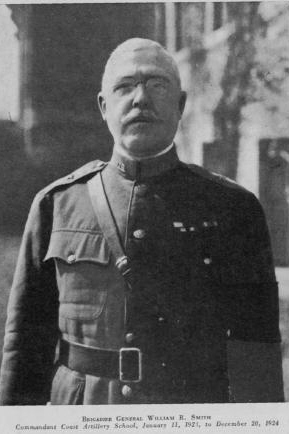William Ruthven Smith facts for kids
Quick facts for kids
William Ruthven Smith
|
|
|---|---|
 |
|
| Born | April 2, 1868 Nashville, Tennessee |
| Died | July 15, 1941 (aged 73) Sewanee, Tennessee |
| Allegiance | |
| Service/ |
|
| Years of service | 1892 - 1932 |
| Rank | |
| Commands held | Superintendent of the United States Military Academy |
| Awards | Distinguished Service Medal |
William Ruthven Smith (April 2, 1868 – July 15, 1941) was a career United States Army officer who commanded the 36th Infantry Division during its deployment in France during World War I and later became Superintendent of the United States Military Academy at West Point, New York.
Early life
William Ruthven Smith was born on April 2, 1868, in Nashville, Tennessee, son of Robert McPhail and Lititia (Trimble) Smith. The younger Smith attended Vanderbilt University and was appointed to the United States Military Academy from his native state, graduating 10th out of 62 cadets in his class of 1892.
Military career
Smith's early postings alternated between garrison service in field artillery and teaching at West Point as instructor of the separate subjects of chemistry, mathematics, ordnance, and gunnery. Made captain of the new Coast Artillery Corps in 1901, he was a student of the school of submarine defense and commanded Fort Monroe in 1908. In the years preceding World War I, Smith commanded anti-submarine technology schools and departments, in early 1917 stretching "the first submarine net put down in America, 2000 yards long, 84 feet at deepest point, extending from Fort Monroe to Fort Wool and closing entrance to Hampton Roads"
Promoted to colonel of the Coast Artillery Corps in May, 1917, Smith was made a brigadier general of the National Army and assigned to train the 62nd Field Artillery Brigade, 37th Division (Ohio National Guard). After training that command for nine months at Camp Sheridan, Alabama, Smith traveled with the Guard unit to its embarkation for Europe, but was left on the docks when their ships departed on June 10, 1918, by order of the War Department.
Smith was given command of the 36th Infantry Division and promoted to major general of the National Army in the Summer of 1918. After arriving in Brest, France, the 36th Division, Smith established a combat course for training at Bar-sur-Aube. In October 1918, Smith led the 36th Division while with 2nd Division it was attached to the French Fourth Army under Henri Gouraud on its push to the Aisne River. Smith remained in command of the division's demobilization in June 1919, when his National army rank dissolved, his rank reverted again to colonel, U.S. Army.
After promotion again to brigadier, this time of the regular army, Smith served in several garrison commands in the Philippines, Fort Sam Houston, Fort Monroe again, and Honolulu, Hawaii, then returned to the academy, this time to occupy the superintendent's billet from 1928 until 1932. During his tour as superintendent, Smith helped secure Stewart Field in nearby Newburgh, New York as a base for the Army Air Corps and USMA pilot training.
Civilian career
After retirement, Smith returned to his native state of Tennessee, settling in Sewanee where he became superintendent of the local military academy (now St. Andrew's-Sewanee School) and served in that capacity until his death.
Death and legacy
He died on July 15, 1941 in West Point, New York. Battery Smith at Fort Miles, Delaware (also called Battery 118) was named for him, armed with two 16-inch guns.

